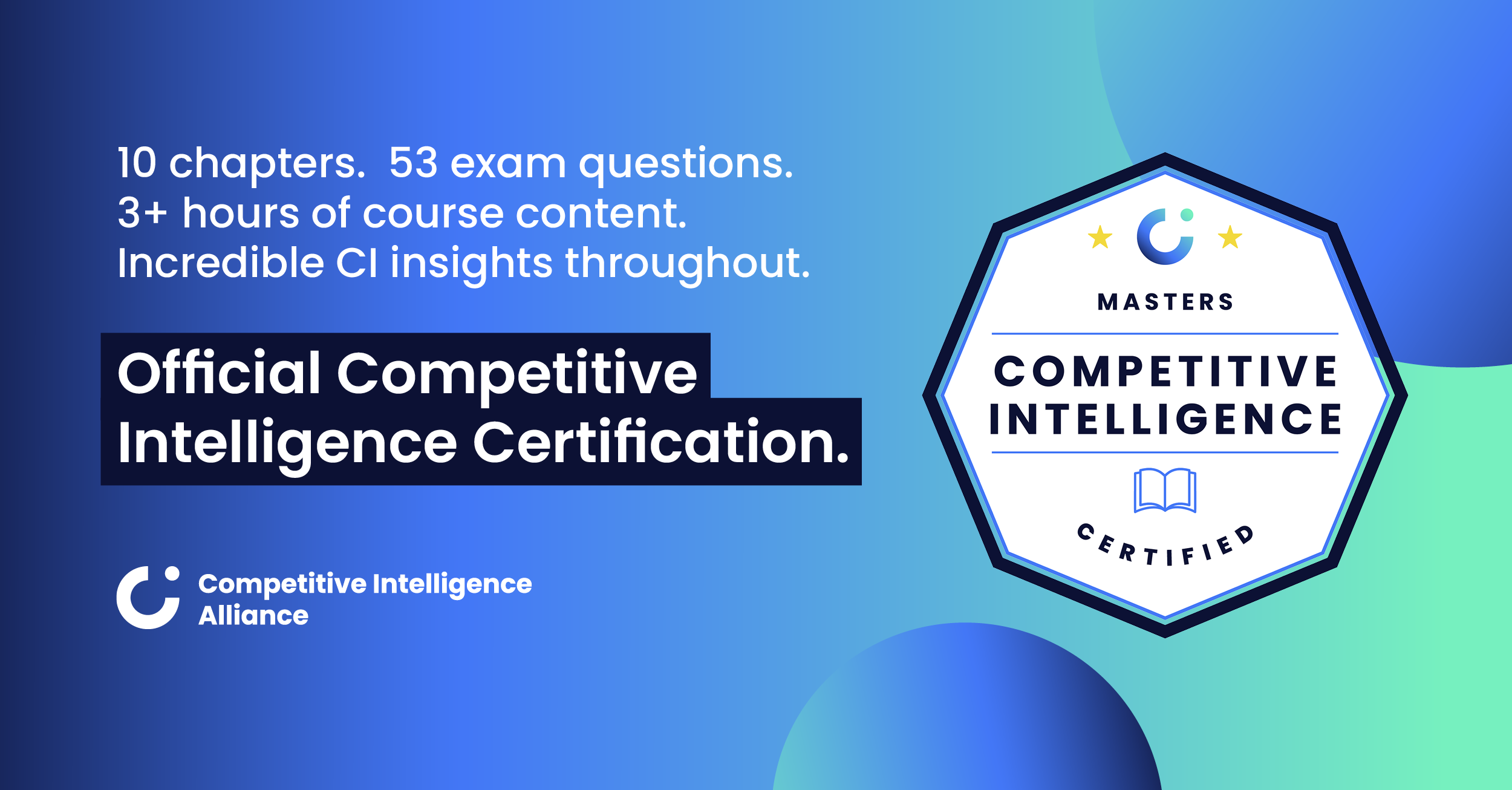Picture this: a marketplace buzzing with competitors vying for the attention of customers.
Sounds familiar, right?
In such a fiercely competitive environment, how can your business rise above the rest?
The answer lies in harnessing the power of competitive intelligence for your marketing strategy.
By working closely with your marketing teams, you can weave your competitive positioning into your prospects’ buying process from the outset. That way, you’ll be the obvious choice when it’s time to buy.
The goal is to have potential customers see and define their problem in the same way you do – even before they engage with a sales executive. If you can pull this off, your product’s unique differentiators will be seen as must-haves rather than nice-to-haves in the eyes of the customer.
Let’s dive into how you can make this happen.
Your key deliverable: The competitive positioning document
For your competitive differentiation to shine through your marketing, you’ll need to equip your marketers with the right tools. These should come in the form of a living document that supports everyone from your content marketers to your events folks with clear competitive positioning.
That way, whenever you're asked to provide input on new landing pages, product launches, or content campaigns, you’ll be able to refer your teams back to this key document.
Wondering what you should include in your competitive positioning document? Keep reading to find out.

No product is created in a vacuum
The Competitive Positioning Playbook teaches you...
👷 How to blend CI and customer research for a rock-solid positioning strategy.
🙅♀️ The three steps you must not skip in crafting competitive positioning.
🪛 A top-to-bottom tear down of the positioning process, and how CI fits in.
🏹 How to use competitive positioning to shatter your org’s revenue ceiling.
Interested? Click the button right now to check it out.
Your overall competitive position
You’ll want to start by outlining the alternative products available to customers and how they address the problem at hand. It’s important to acknowledge the strengths of these alternatives. From there, you can reframe those strengths to present a fresh perspective on the issue.
Let’s say your product is a project management tool targeted at small and medium businesses, (SMBs) and your biggest competitor’s solution is more tailored to enterprises. This is your opportunity to highlight the features that make your platform more suitable for this segment.
Maybe it’s cheaper. Maybe it’s faster and easier to implement. Whatever your key differentiator, make sure your marketing teams know about it.
Education for the market
It’s also a great idea to equip your marketing teams with topics that, if better understood by the market, could enhance your competitive advantage. Coming back to the project management platform example, you might want to ask yourself, “If more people knew about Agile methodologies, how would that impact our ability to compete?”
To make sure you’re focusing on the right topics, you’ll need to draw from your win-loss analyses. Look out for the differentiators that customers failed to appreciate or didn’t understand, then share these findings with your marketing teams so they can develop educational content on these topics.
The aim here is not just to promote your product, but to provide valuable information on industry trends or relevant skills. By raising interest and understanding of these topics within the market, you’ll ultimately be better able to sell your unique differentiators.
A platform that’s killing it on this front is Monday.com. Their blog is full of guides to Gantt charts, Agile project management, and no-code applications. These guides are not only informative, but they prime readers to understand and care about the features Monday.com offers.

Intel on competitors’ approaches
It’s also essential for your marketing team to stay informed about how competitors are addressing those educational topics we’ve just looked at.
A competitive intelligence tracking platform is really going to help you here. A quick search is going to bring up competitor blogs, webinars, and documentation related to the topics you’re going after. You’re going to want to dig into this content and figure out how to make sure you don’t sound like everybody else who’s talking about this topic – that’s what’ll make you stand out.
Keywords for SEO
If you want to compete in the digital world, you've got to give your digital marketing and SEO teams clear direction about which keywords to focus on. By identifying the keywords that align with your competitive position, you’ll enable your teams to optimize content, improve search rankings, and drive targeted traffic to your brand. Remember, a shared understanding of these keywords is essential for cohesive and impactful marketing efforts.
Strategic language choices
Beyond keywords, it's vital to equip your marketers with specific language that emphasizes key product moments and the defining features that set your brand apart.
Just as important as the language to include is the language to avoid. Your market research may have uncovered certain product categories or terms that don't mesh well with your brand – perhaps they’re a little dated or too strongly associated with a legacy product. By clearly stating which terms to stay away from, you can make sure your marketing team stays on brand and conveys your unique value proposition in the right way.
Three bonus ways to enable your marketing teams with CI
Now that we’ve covered what you’ll need to include in your competitive positioning document, let’s dive into three more ways you can empower your marketing teams with competitive intel.
Tactic #1: Tracking competitor strategies
As well as nailing down the keywords you want to go after, it’s a smart idea to work with your SEO and digital marketing teams to track the keywords your competitors are going after.
This is going to give you valuable insights into their strategies and maybe even help you anticipate their next moves. If a competitor is focusing their search engine marketing (SEM) efforts and a keyword that doesn’t line up with their current product offering, they may be laying the groundwork for an upcoming launch. Getting ahead of that launch could give you a make-or-break advantage.
Learn how to carry out a competitive SEO analysis.

Tactic #2: Building competitor comparison pages
You can also collaborate with your marketing teams on landing pages designed to compete for comparative search terms, terms like “[your product] vs [competitor’s product]” or “alternatives to [your product]”.
These pages should be concise, focused, and transparent. Don’t try to mislead people by pretending to be an unbiased third party. Instead, cut to the chase and show where your product outshines its competitors. Remember, these are pretty high-intent search terms, so readers aren’t going to want to waste their time on fluff.
While it can be tempting to use these pages to trash-talk your competitors, that’s never a good idea. It’s a cheap move your prospects will see right through. Keep the comparison as objective as you can and guide your customers to the right choice for them. Acknowledging your competitor's strengths before you get into the features that set your product apart is going to make you appear way more unbiased and trustworthy, ultimately resulting in more conversions.
Asana, another project management tool, has nailed the art of the comparative landing page. Searching “Trello vs Asana” takes you to a clean and simple landing page with a chart laying out all the features Asana offers that its competitor does not.
Competitive intelligence pros, take note!

Tactic #3: Optimizing new user onboarding
If your marketing team oversees new user onboarding, use this as an opportunity to emphasize the most distinctive aspects of your product.
During the trial phase, there’s a good chance your users are exploring several options at once, only spending a little time with each solution before moving on to the next. That means you don’t have much time to create a lasting impression; use what little time you have to highlight the features that make your product stand out.
Of course, your differentiated features may only show up in more advanced use cases for your product. If you bring these features into the onboarding journey too soon, you risk overwhelming your users. Keep that in mind, and focus on showcasing differentiators that resonate with users’ immediate needs as soon as you can.

TL;DR
Phew! That was a lot! Let’s recap the key takeaways:
- Develop a living competitive positioning document that supports your marketing teams with clear competitive positioning, ensuring cohesive and impactful marketing efforts.
- Outline alternative products, acknowledge their strengths, and reframe them to present a fresh perspective that highlights your unique features.
- Provide educational content to enhance your competitive advantage and raise interest and understanding within the market.
- Help your marketing teams to stay informed about your competitors' approaches through competitive intelligence tracking platforms and differentiate your messaging to stand out.
- Guide your digital marketing and SEO teams on the keywords to focus on for improved search rankings and targeted traffic.
- Equip your marketers with strategic language choices that emphasize key product moments and differentiators, while avoiding language that doesn't align with your brand.
- Build comparative landing pages that highlight where your product slays the competition.
- Optimize new user onboarding to showcase your product's key differentiators.
Competitive intelligence is about so much more than just churning out battlecards. It’s on you to harness the full potential of CI for all your teams – marketing included.
Want to learn how to deliver competitive intelligence to other stakeholder groups?
Our Competitive Intelligence Certified: Masters qualification teaches you everything you need to know to effectively:
- Deliver intel that gets people talking, no matter which set of stakeholders you serve. 📣
- Set up your listening stack to gather competitive intel with ruthless efficiency, giving you more time to analyze, enable, inform, and become your business’s champion. 💪
- Set up win/loss interviews to unveil the powerful reasons why customers aren’t choosing you, even if you’ve got no time or resources. 🔎
This brand new course that covers every aspect of competitive intelligence, and what it takes to be successful.
Interested? Click below right now to check it out.






.png?v=09cf73b4b5)